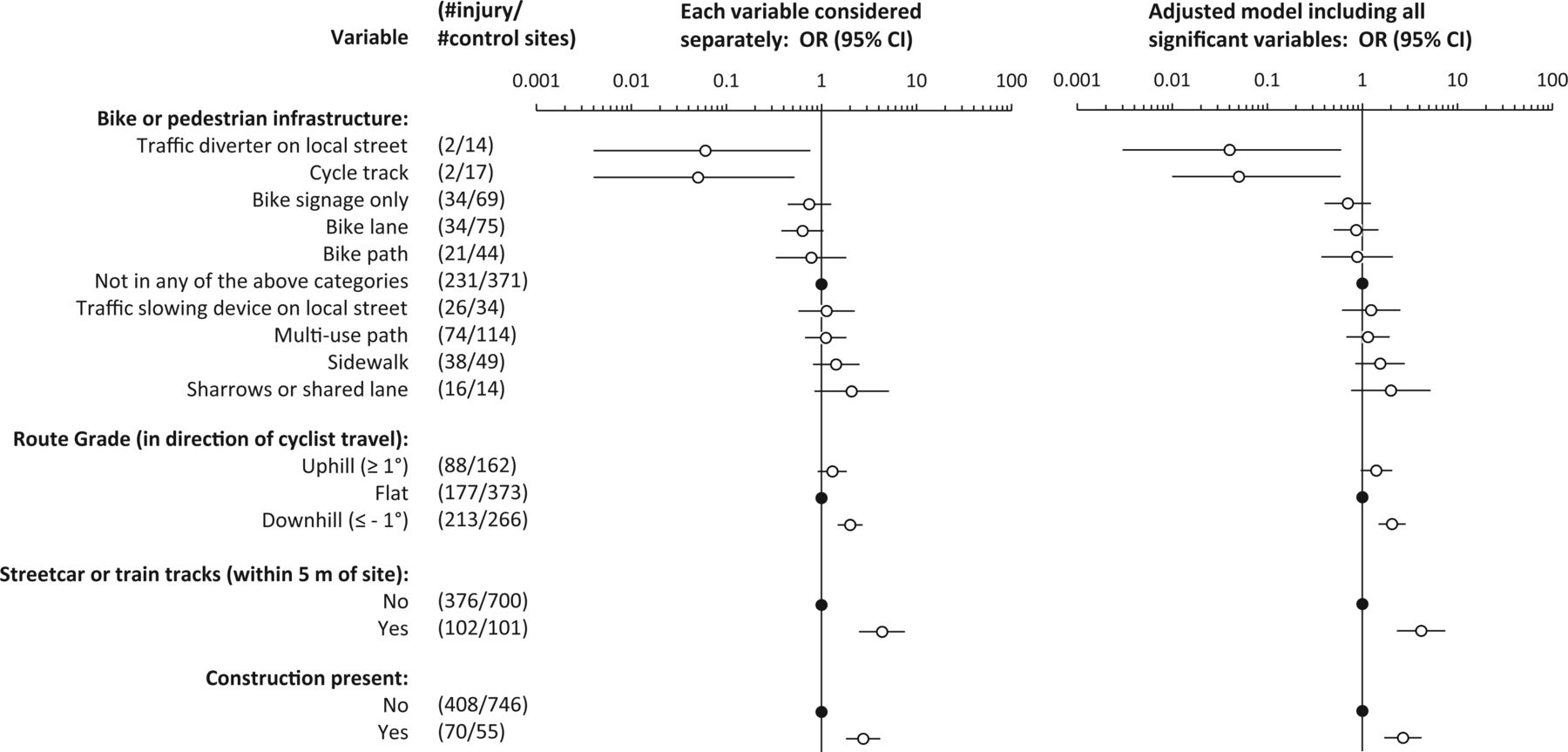Army-Navy Drive losing a bit of the bike lane?
Our Community › Forums › Road and Trail Conditions › Army-Navy Drive losing a bit of the bike lane?
- This topic has 71 replies, 18 voices, and was last updated 7 years, 9 months ago by
ginacico.
-
CreatorTopic
-
March 28, 2017 at 12:51 am #919241
DrP
ParticipantI bike home along Army-Navy Drive from Pentagon City towards Glebe (or the 4MRT, to be exact). A couple of weeks ago they dug up a small bit of the miniscule sidewalk and bike lane on the I-395 side of the road across from the Horizon House Condos at the bus stop. They appear to have added a sidewalk-height manhole cover and appear to be putting in a curb such that there is no bike lane at that point. Any one know what is going on? Will they re-paint lines to keep a bike lane there or do I have to continue doing what I do now and take the lane at that point?
-
CreatorTopic
-
AuthorReplies
-
March 30, 2017 at 7:08 pm #1068894
CaseyKane50
Participant@DrP 157841 wrote:
I bike home along Army-Navy Drive from Pentagon City towards Glebe (or the 4MRT, to be exact). A couple of weeks ago they dug up a small bit of the miniscule sidewalk and bike lane on the I-395 side of the road across from the Horizon House Condos at the bus stop. They appear to have added a sidewalk-height manhole cover and appear to be putting in a curb such that there is no bike lane at that point. Any one know what is going on? Will they re-paint lines to keep a bike lane there or do I have to continue doing what I do now and take the lane at that point?
Good news, the manhole cover has been addressed. There is now a nice bus pad surrounding the manhole cover. The bad news is the bike lane has definitely disappeared. It will take some restripping of the travel lanes to even hope for a bike lane. I sure hope the county has some plans to address the abrupt end of the bike lane. This is now a quite hazardous bike lane.
[ATTACH=CONFIG]14490[/ATTACH]
March 30, 2017 at 7:16 pm #1068895KLizotte
ParticipantSo now there is a dangerous “step down” around the manhole cover?! Wouldn’t it have made more sense to move the bus stop 15-20 feet in either direction so a smooth apron could be built? Doesn’t look like it meets ADA standards.
March 31, 2017 at 2:52 pm #1068928Bike-Ped Manager
ParticipantNo, the southbound bike lane is not going away. This is one of three consecutive bus stops along Army Navy Drive (southbound) that are being made ADA accessible in coordination with a repaving project along the corridor. After it gets paved (later in the summer, I’m told) a new striping plan will adjust all the travel lanes accordingly. The silver lining to all this disruption is that as part of this re-striping process, the northbound bike lane will be converted to a buffered/protected bike lane wherever there is room to do so.
October 2, 2017 at 8:38 pm #1076405 chris_sParticipant
chris_sParticipantFrom an Arlington County Email Update:
After portions of Army Navy Drive were repaved this summer, new street markings are scheduled to be installed within the next two weeks between Joyce Street and the bridge connecting to the Army Navy Country Club.
The new markings will include a protected bicycle lane in the northbound direction and a buffered bike lane in the southbound direction. New crossings to provide access to transit will be installed as well.
In the sections where the protected bike lane will be marked, the current bicycle lane will be flipped to the inside – against the curb. The parking lane will be between the bicycle lane and the vehicle travel lane.
Both the protected lane and the buffered bike lane will enhance bicycle safety and connectivity in the area, and will also serve to narrow the relatively wide street and calm vehicle speeds.
October 2, 2017 at 9:44 pm #1076408 JuddParticipant
JuddParticipant@chris_s 166117 wrote:
From an Arlington County Email Update:
After portions of Army Navy Drive were repaved this summer, new street markings are scheduled to be installed within the next two weeks between Joyce Street and the bridge connecting to the Army Navy Country Club.
The new markings will include a protected bicycle lane in the northbound direction and a buffered bike lane in the southbound direction. New crossings to provide access to transit will be installed as well.
In the sections where the protected bike lane will be marked, the current bicycle lane will be flipped to the inside – against the curb. The parking lane will be between the bicycle lane and the vehicle travel lane.
Both the protected lane and the buffered bike lane will enhance bicycle safety and connectivity in the area, and will also serve to narrow the relatively wide street and calm vehicle speeds.
Sorry short people…. you’re gonna get right hooked.
October 3, 2017 at 12:43 am #1076415ginacico
Participant@Judd 166121 wrote:
Sorry short people…. you’re gonna get right hooked.
Actually, the marked bike lane is only the section between the country club underpass and Lynn. So there’s only one intersection (at Nash) to be concerned about, and the way it’s configured there are no dangerous blind spots.
Hopefully it will slow down traffic (especially the buses) as designed. IMO, I think it’s a win.
October 3, 2017 at 2:47 am #1076420 JuddParticipant
JuddParticipant@ginacico 166128 wrote:
Actually, the marked bike lane is only the section between the country club underpass and Lynn. So there’s only one intersection (at Nash) to be concerned about, and the way it’s configured there are no dangerous blind spots.
Hopefully it will slow down traffic (especially the buses) as designed. IMO, I think it’s a win.
My bias against car “protected” bike lanes is strong. I don’t go this way much so I had to look at Google Maps. It looks like there are a few driveways along the way too. If I remember correctly, there’s usually not a lot of cars parked here anyway.
October 3, 2017 at 11:31 am #1076423DismalScientist
Participant@Judd 166133 wrote:
My bias against car “protected” bike lanes is strong.
Good luck with that. As far as I can tell, we are an ignored constituency. Something about the powers that be wanting to kill off Isabella with right hooks…
October 3, 2017 at 12:22 pm #1076424 chris_sParticipant
chris_sParticipant@DismalScientist 166136 wrote:
Good luck with that. As far as I can tell, we are an ignored constituency. Something about the powers that be wanting to kill off Isabella with right hooks…
Yep, that’s it.
After New York City installed a protected bike lane on Columbus Avenue, bicycling increased 56 percent on weekdays, crashes decreased 34 percent, speeding decreased, sidewalk riding decreased, traffic flow remained similar, and commercial loading hours/space increased 475 percent.
New York City Department of Transportation, 2011Streets with protected bike lanes saw 28 percent fewer injuries per mile than comparable streets with no bike infrastructure. People were also 2.5 times more likely to bike on the protected lanes than in general travel lanes.
Lusk, A., et al., 2010 – Risk of injury for bicycling on cycle tracks versus in the street, Injury Prevention, December 1, 2010Streets with protected bike lanes saw 90 percent fewer injuries per mile than those with no bike infrastructure.
Teschke, K., et al., 2012 – Route Infrastructure and the Risk of Injuries to Bicyclists: A Case-Crossover Study96 percent of people using protected bike lanes believe they increased safety on the street.
Monsere, C., et al., 2014 – Lessons from the Green Lanes (National Institute for Transportation and Communities)Protected bike lanes reduce bike-related non-intersection injuries by about 75 percent compared to comparable crossings without infrastructure.
Harris et al, 2013 – Comparing the effects of infrastructure on bicycling injury at intersections and non-intersections using a case?crossover design.” Injury Prevention”October 3, 2017 at 1:16 pm #1076426DismalScientist
ParticipantI note that these studies compare PBLs with no bike infrastructure, not choice of infrastructure.
October 3, 2017 at 1:24 pm #1076388 lordofthemarkParticipant
lordofthemarkParticipant@DismalScientist 166139 wrote:
I note that these studies compare PBLs with no bike infrastructure, not choice of infrastructure.
So many studies available to do!! Car protected vs flex post “protected”, Car protected vs buffered, car protected vs door zone bike lanes, car protected vs conventional bike lanes without parking.
I am pretty sure that protected by concrete buffers would (pardon the expression) trump car protected, because they would have the advantages claimed for car protected, without the visibility issue. Unfortunately removing parking continues to be an issue in many places.
October 3, 2017 at 1:40 pm #1076427 chris_sParticipant
chris_sParticipant@DismalScientist 166139 wrote:
I note that these studies compare PBLs with no bike infrastructure, not choice of infrastructure.
From the last study in the list:
 October 3, 2017 at 1:59 pm #1076428
October 3, 2017 at 1:59 pm #1076428 lordofthemarkParticipant
lordofthemarkParticipant@chris_s 166142 wrote:
From the last study in the list:

Note that table is for non-intersection locations, for intersections, presence of bike infra apparently had no statistically significant impact.
October 3, 2017 at 2:34 pm #1076432DismalScientist
ParticipantThe study had 2/3rds of injuries at non-intersection locations. Is this typical?
Site matching procedure seems arbitrary and am wondering whether a fixed effects model is appropriate, although there is insufficient data. Given the inherent choices being made by cyclists, endogeneity is often an issue. I don’t think using the cyclists prior path solves this as it suggests that each intersection is an independent choice and not path-dependent. There is also a big selection issue as different types of cyclist may choose different types of infrastructure.
Lastly, this shows that cycle paths are safer between intersections than bike paths and bike lanes are slightly safer than bike paths. This seems counterintuitive.October 3, 2017 at 2:39 pm #1076433 JuddParticipant
JuddParticipant@DismalScientist 166136 wrote:
Good luck with that. As far as I can tell, we are an ignored constituency. Something about the powers that be wanting to kill off Isabella with right hooks…
Won’t someone think of the people that want to turn left?
-
AuthorReplies
- You must be logged in to reply to this topic.